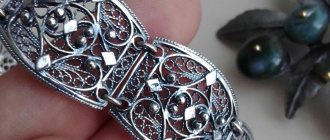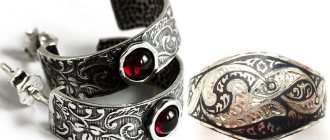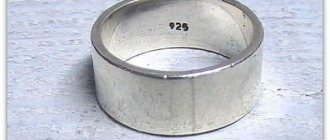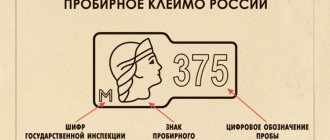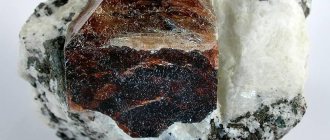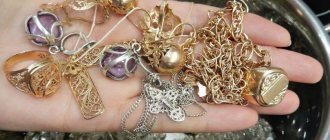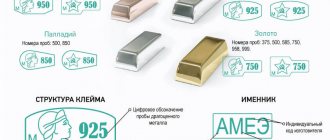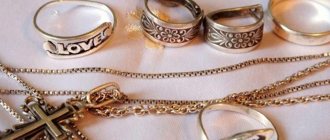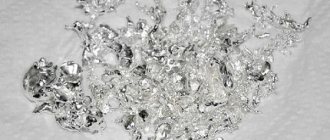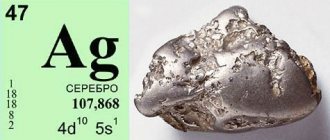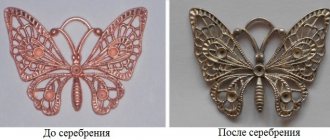Blackened silver is gaining popularity among buyers, since jewelry made from this type of precious metal has an unusual appearance that is distinguished by sophistication and looks like an antique.
Blackened silver ring
The following types of silver are used in jewelry:
- Sterling. This term refers to plain 925 sterling silver without additional plating. Therefore, sterling silver items require care and cleaning to remove tarnish. The test is popular in the manufacture of not only jewelry, but also cutlery.
- Blackened. Outwardly it looks like darkened silver, but the effect is achieved artificially. Does not require special cleaning.
- Oxidized. It looks like a blackened precious metal, but the effect of applying a dark layer is cheaper and short-lived.
- Rhodinated. Applying a layer of rhodium to a product without changing its color. This is done to protect the jewelry from scratches and darkening.
Blackened silver jewelry
Copper is mainly added to silver alloys. As a result, the product becomes hard, acquires good anti-corrosion characteristics, and improves its appearance. In the Russian Federation, jewelers work only with several samples of silver. The sample is a mark, a passport of the product. She talks about the amount of pure silver in the product. 925 standard suggests 92.5% of the metal itself, the remaining 7.5% being various impurities. There are several types of silver, such as blackened silver.
Sulfuric ointment
You can quickly and effectively darken silver using sulfur ointment. This is a medicine that is mainly used to combat scabies pathogens in both humans and animals. Therefore, it is sold both in veterinary and regular pharmacies.
Sulfur ointment is thick, yellow in color and has a rather unpleasant odor. It must be applied to the product, and then heated to a fluid state using a hairdryer. After the ointment has transformed into a more liquid state, it can be more carefully distributed on the surface of the silver. When heated, you will see how the metal acquires a rich black-blue or purple color. Afterwards, the product can be wiped dry; if necessary, the procedure can be repeated.
Varieties of silver
Silver has a white-silver color. At the moment, the following types of this metal are distinguished: filigree, matte, blackened, coin. Each species has its own specific characteristics.
Matte silver does not have bright patterns. To obtain it, various emulsions are applied to the raw materials. The use of emulsions allows you to make the surface rough and give it additional charm. The product turns out to be original, beautiful, unusual.
Distinctive characteristics of filigree silver are a variety of openwork patterns. Since silver has high malleability and strength, thin threads are made, giving the product a beautiful and unusual design. Making filigree silver requires professionalism and takes quite a lot of time. Jewelers highlight background and openwork filigree. For an openwork look, a through pattern is implied.
Sterling silver is the main material used in jewelry. This material has a smooth surface, silver-white color, excellent strength, and a long service life. The sterling material contains 92.5% pure silver and 7.5% copper.
LiveInternetLiveInternet
- Registration
- Entrance
—Categories
- CROSS STITCH (538)
- blouses (17)
- curbs (28)
- children's (24)
- paintings (69)
- monochrome embroidery (89)
- pillows, tablecloths, napkins (76)
- usefulness (12)
- holidays (23)
- miscellaneous (108)
- COOKING: MEAT DISHES (580)
- in the sleeve (18)
- beef (32)
- chicken (208)
- cutlets (108)
- chicken (31)
- pork (129)
- AVATARS (6)
- BEADING (340)
- butterflies (15)
- collars (50)
- embroidery (23)
- necklace (45)
- usefulness (16)
- souvenirs (22)
- flowers, trees (65)
- eggs (21)
- EMBROIDERY (308)
- ribbon embroidery (17)
- usefulness (7)
- MISCELLANEOUS (53)
- rococo (36)
- stitches (56)
- CROCHET (1098)
- Irish lace (144)
- costumes. dresses (12)
- Romanian lace (105)
- napkins (116)
- fabric + lace (40)
- sirloin (140)
- hats (328)
- CROCHET FOR WOMEN (1072)
- blouses (648)
- tunics (217)
- shawls, stoles (123)
- CROCHET: PATTERNS (780)
- flowers (132)
- KNITTING ON A FORK (60)
- KNITTING (1725)
- for men (72)
- vests (61)
- mittens (28)
- sweaters (28)
- patterns (1538)
- KNITTING FOR CHILDREN (663)
- girls (227)
- crochet (131)
- knitting needles (306)
- KNITTING FOR WOMEN (1942)
- vests (118)
- fur (46)
- blouses (1168)
- dresses.skirts (79)
- sweaters (228)
- tops, coats (77)
- shawls, stoles (209)
- DECOUPAGE (26)
- decoupage on stones (20)
- KIDS (28)
- HEALTH (1946)
- video charging (181)
- hair (30)
- eyes (31)
- diet (19)
- diet (35)
- teeth (18)
- cosmetics (91)
- medicinal herbs (209)
- ointments (9)
- makeup (22)
- face mask (126)
- massage (76)
- calluses. corns (15)
- legs (75)
- necessary (121)
- anti-wrinkle (67)
- cleansing (43)
- kidneys (33)
- miscellaneous (256)
- handles (23)
- vessels (75)
- joints (80)
- INTERIOR IDEAS (261)
- living room (13)
- kitchen (16)
- miscellaneous (18)
- miscellaneous (6)
- bedroom (2)
- MOVIE SHOW (98)
- audiobooks (7)
- WWII (19)
- COOKING (1437)
- zucchini dishes (63)
- main courses (139)
- blanks (260)
- candies.cookies (158)
- culinary benefits (149)
- multicooker (70)
- fish (213)
- salads (218)
- sauces, adjika (104)
- COOKING: BAKING (1483)
- no bake (31)
- biscuit (43)
- pancakes (51)
- buns (50)
- buns (8)
- from cottage cheese (107)
- cupcakes (122)
- cream (17)
- in a frying pan (29)
- pancakes (21)
- cookie. nuts (181)
- pies (210)
- pies (157)
- pizza (18)
- healthy baked goods (6)
- cutting dough (51)
- miscellaneous (109)
- bagels (24)
- dough (40)
- cakes (103)
- brushwood, donuts (60)
- pasties (11)
- COOKING: VEGETABLES (310)
- MOLDING (398)
- plaster (89)
- plastic, polymer clay (113)
- salt dough (26)
- cold porcelain (136)
- MASTER CLASSES (78)
- MUSIC (66)
- NEW YEAR (363)
- wreaths (102)
- fortune telling (3)
- spells for the New Year holidays (27)
- congratulations (10)
- SOCKS.BOOTIES.SLIPPERS (291)
- ABOUT EVERYTHING (322)
- audiobooks (9)
- biographies (29)
- lunar day (60)
- fairy tales (4)
- learn English (31)
- BLOG DESIGN (168)
- computer usefulness (96)
- EASTER (248)
- decor (43)
- Easter cakes (41)
- congratulations (1)
- omens (31)
- omens (10)
- WEAVING (75)
- macrame (57)
- NEWSPAPER WEAVING (293)
- CRAFTS (1303)
- butterflies (28)
- jars, bottles (90)
- bows (30)
- various bouquets (29)
- decorative things (145)
- decoupage (102)
- From paper (121)
- leather (48)
- from corn leaves (30)
- burlap (109)
- quilling (20)
- dolls (200)
- my wishes (5)
- papier-mâché (47)
- miscellaneous (15)
- fish (4)
- stencils (69)
- filigree (75)
- KNITTING USE (935)
- closing loops (38)
- yarn (32)
- miscellaneous (57)
- connecting parts (24)
- crochet lessons (166)
- knitting lessons (443)
- symbols (6)
- cords (8)
- USEFUL TIPS (38)
- USEFUL TIPS (603)
- for home (300)
- for work (8)
- household (250)
- LET'S LAUGH (27)
- SIGNS. SUPERSTITION (2132)
- fortune telling (94)
- glyphs (5)
- horoscopes (108)
- birthday (16)
- money (113)
- house (70)
- conspiracies (91)
- health (36)
- mudras (14)
- new year (34)
- numerology (61)
- Easter (6)
- miscellaneous (183)
- runic basics (81)
- runes (289)
- runes-money (178)
- runes-house (46)
- runes-protection (87)
- health runes (122)
- runes-beauty (14)
- runes-work (40)
- runes-miscellaneous (206)
- evil eye (14)
- palmistry (76)
- RELIGION.PRAYERS (123)
- DRAWING (27)
- DIARY PATTERNS (76)
- SMART TIPS (93)
- FLASH GAMES (6)
- I WANT (86)
- FLOWERS (826)
- for a summer residence (283)
- fabric (129)
- indoor flowers (160)
- beauty of flowers (57)
- topiary (84)
- SEWING (748)
- boho (90)
- trousers (26)
- for Tusi (15)
- from jeans (44)
- small things (26)
- alterations (41)
- scarves (59)
- miscellaneous (236)
- transformers (9)
- aprons (7)
- THIS IS INTERESTING (5)
Blackening technology
Since ancient times, craftsmen have tried to decorate their products (weapons, jewelry, dishes) with ornaments, drawings, and unusual patterns. Technologies for applying ornaments have changed and improved. Blackened silver is produced using a special technology. It is used in the processing of jewelry, as well as in applied arts. In Rus', blackening has developed since the mid-20th century. Unique rings made of blackened silver, made by craftsmen from Veliky Ustyug (Vologda region), were in demand. In the 18th and 19th centuries, dishes, cigarette cases, and trays were made using a similar technology. Master jewelers mastered numerous subtleties of the craft, but they did not pass on their knowledge, and therefore some of the nuances were lost. Blackened silver was quite expensive, so only wealthy people could afford such products. The essence of blackening was to coat pure metal with black. The product became embossed and acquired a refined appearance.
Features of blackening
This technology is aimed at obtaining unusual patterns on the product. A special technology has been developed that produces blackened silver at home. First, the jewelry is engraved or minted, then a special solution is applied to it, including oxides of lead, copper, and silver. The surface of the product must be clean; all grease stains must first be removed from it. To melt the solution, the product is heated. As a result, a beautiful black pattern appears on the silver surface.
What it is?
Niello has long been used to decorate silver and gold items. This technique allows you to paint metal black. Contrast appears on the surface, which makes the product more “alive”. The technique is used when there are drawings or simple relief.
Blackening consists of an alloy of copper, sulfur, silver and lead that is added to the base metal. The material is often used to create unusual jewelry in an antique style. There is no point in applying blackening to a flat surface. First, processing is carried out, drawing a pattern using indentations about 0.3 mm in size. This is where the mob melts in.
When heated, silver and the alloy interact on a chemical level. Thanks to this, decorative properties go together with functional ones. Blackened silver darkens much more slowly from interaction with the environment, so you will have to clean it less often. It is worth noting that niello can be either dark or light. And jewelry with it cannot be rubbed too hard, otherwise the alloy will begin to wear out.
Blackened silver is considered the most durable. The niello quickly peels off gold, so this metal is not decorated using this method. If desired, the silver can be covered with niello, and the free areas can be gilded. Visually, the product will not differ from a more expensive one.
In the modern world, factory technologies for galvanizing blackening are used. In the recent past, reception was carried out completely differently.
Known methods for making niello are presented below.
- German. Lead is slowly poured into the copper-silver alloy, and the entire composition is constantly stirred. Next, the composition is poured into heated sulfur powder. It is necessary to constantly mix the metals. This guarantees better interaction at the chemical level. At this stage, the entire alloy is poured into water. The frozen niello is finely ground in a porcelain mortar in the required quantity. Only fresh and wet alloy is applied to the products.
- Modern Moscow. First, an alloy of copper, silver and lead is prepared. Sulfur powder is poured in small portions. Now the key difference: the composition is poured into a cast iron frying pan. After solidification, the metal is crushed and melts again. This time the alloy is supplemented with sulfur and flux. To obtain special quality mobile, the entire process is repeated three times.
The finished substance is crushed in mortars and sifted using a sieve.
- Pre-revolutionary Russian. A. G. Spassky came up with this unusual method. Now it is called copyright. Silver, lead sulfide and the same copper are prepared separately. Each component in a certain amount is added to the total container to create the alloy. Next, you need to melt the composition in a certain way and cool it for further use.
No less interesting are the methods of applying compositions to jewelry. There are only two of them.
- Dry. The surface is treated with a solution, which makes it wet. The most crushed black powder is applied on top. After drying, the product is fired at a temperature of about 300-400°C.
- Wet. Black mixed with water is applied to the surface in the form of a porridge. The consistency is reminiscent of sour cream. The composition is distributed densely and densely throughout the product, filling all the recesses. Craftsmen use brushes or small spatulas. All you have to do is wait for the water to evaporate and you can heat the surface in the muffle. There the rabble softens and flows into all the cavities. The decoration is removed from the oven. It is worth noting that small parts are heated using a soldering gun.
After plating by any method, the jeweler must clean the jewelry by scraping or using a file. As a result, the excess alloy will be removed and the pattern will appear. The background surface is decorated after blackening. Engraving or some small details are applied.
Benefits of blackened silver
Such products have numerous advantages. This material does not require additional cleaning and retains its aesthetic appearance. Such an alloy also has certain limitations. Boiling with soda, for example, removes blackening. Dishes created using this technology have long been used to store valuables, amulets, and elixirs. In ancient times, the bactericidal properties of blackened silver were considered a manifestation of magic. People sincerely believed that blackened silver protected against failure and evil spirits.
Metal oxidation
Currently, many products similar to natural blackening are made using oxidation. Today it is difficult to buy real blackened silver. The jewelry offered on jewelry store shelves is mostly created by coating a silver item with a thin oxide film. Over time, it wears off and the jewelry loses its shine. Real earrings made of blackened silver have a fairly high price. When the cost of 1 gram of ordinary silver is 30-40 rubles, the price for 1 gram of blackening increases 10 times. Such jewelry has a high cost due to manual labor and individual work of the master.
Mechanical method
How to darken silver at home with graphite? This is a fairly simple technology, and its result is due to the same processes that occur with lunar metal over time. That is, dust particles stick to it and firmly “eat” into the recesses. Using graphite you can simply speed up this process.
To blacken the product, they are lubricated with a mixture of graphite powder, iron oxide and turpentine, diluted to a pasty state. Then wait for it to dry completely and wipe the silver with a soft cloth. The older the product, and the more uneven its surface, the more noticeable the result will be. But in general, such blackening is less durable than that obtained by chemical or galvanic methods.
Useful tips
When choosing a product made of blackened silver, you need to carefully inspect the jewelry, check the presence and quality of the mark, and also get acquainted with the accompanying documents for the product. In Rus' there was a belief according to which silver dishes with blackening protect the family life of the owner of the house. If household items were lost, great misfortune awaited the owner of the house and its inhabitants. Blackened silver was used to make coins, rings, earrings, bracelets, and amulets.
Currently, jewelers are trying to combine silver in jewelry with semi-precious or precious stones. Natural emeralds, rubies, garnets, and pearls are used as such “additives.” If gold adds age to a person, then silver, on the contrary, rejuvenates. It can be worn by women of any age. Jewelry with precious inserts is suitable for special occasions: receptions, presentations. For everyday wear, you can choose items made of blackened silver that do not have inserts.
How to do it at home?
Preparing solutions from metals and making galvanic baths at home is not a good idea. The process requires skills, knowledge and equipment. However, it’s too early to despair; there are simple ways to make your favorite ring more attractive and interesting. Home technology is not only easy, but also does not require much investment. The methods are time-tested and popular among women due to their effectiveness.
Iodine
This method is the most basic and does not require much effort. Blackening with iodine is not suitable for flat products. There will be almost no result. There is one more nuance: the reaction requires bright sunlight. Testing the method in cloudy weather or in winter simply won’t work.
You should not take all this as shortcomings of the method, these are simply its features. Relief decorations can be darkened on a clear day by following the instructions.
- Soak a cotton swab in medical iodine.
- Treat a silver item. Particular care should be taken to wipe hard-to-reach parts.
- Leave the product in the sun until the iodine dries completely.
- Apply toothpaste to a soft cloth and gently polish the product.
Egg
The method is no more complicated than the previous one. The big advantage is that eggs can be found in almost any refrigerator; you don’t even have to rush to the store. Blackening your favorite ring can be very simple.
- Boil 1-2 eggs. The exact quantity depends on how many decorations you plan to process.
- Separate the yolk from the white. The latter is not required for the procedure, so it can be used for any other needs.
- Place the yolks in a container with an airtight lid, crush them thoroughly to a pulp.
- Place the decoration in the same container. It is important that the silver does not come into contact with the yolk. Otherwise, the metal will blacken too quickly and unevenly. The result is unlikely to please. The product can be hung or a paper towel placed inside the container as a barrier.
- Leave the container tightly closed for exactly 24 hours. If after a day the result is unsatisfactory, then you can keep it longer. It is recommended to carry out blackening for no more than 3 days.
- Remove the decoration from the container. Wash with any soap. Polish with a piece of soft cloth.
Sulfur ointment
The drug is used to treat scabies in humans and animals. Sulfur ointment is sold not only in regular pharmacies, but also in veterinary pharmacies. The substance itself is thick, has a yellowish tint and an unpleasant odor. The procedure must be carried out following the recommendations.
- Apply black ointment to jewelry.
- Arm yourself with a hairdryer. Warm the ointment until it begins to flow.
- Gently distribute the already liquid substance over the surface of the silver. It is worth noting that as a result of heating, the metal will already begin to acquire a dark color with a blue or purple tint.
- Use a soft cloth to completely wipe off the ointment from the jewelry. If necessary, repeat the procedure to achieve a more impressive result.
Reviews
Women who have purchased jewelry made of blackened silver primarily note its aesthetic characteristics. Customers are pleased that the product does not require constant cleaning, and there are no allergic reactions from the ring or earrings when worn. Lovers of silver jewelry are convinced that items with blackening are the best choice. Owners of blackened silver accessories note their influence on their mood. Rings and earrings made with blackening protect against unkind glances and help fight troubles. Women who wore such products for a long time found their personal happiness. Ladies of “Balzac age” note that items made of blackened silver make them young and beautiful again.
Silver cleaning using aluminum foil
open sources
open sources
open sources
open sources
open sources
In order to properly clean silver, you need to follow the general rules given below.
- It is necessary to wash silver items regularly.
- Avoid abrasive materials and use only gentle products.
- 925 sterling silver can only be cleaned with special means, as the metal may lose its original appearance.
- Radiant metal should only be cleaned with a soft cloth or swabs, otherwise it will be scratched.
- If you want to add shine to the product, then they should be treated with lemon juice and hot water.
- It is advisable to dry silver on paper napkins.
- It is recommended to polish silver accessories with flannel, wool or suede cloth.
- Experts advise not to wear silver jewelry after you have cleaned it for 3 days until a natural protective layer has formed on it.
